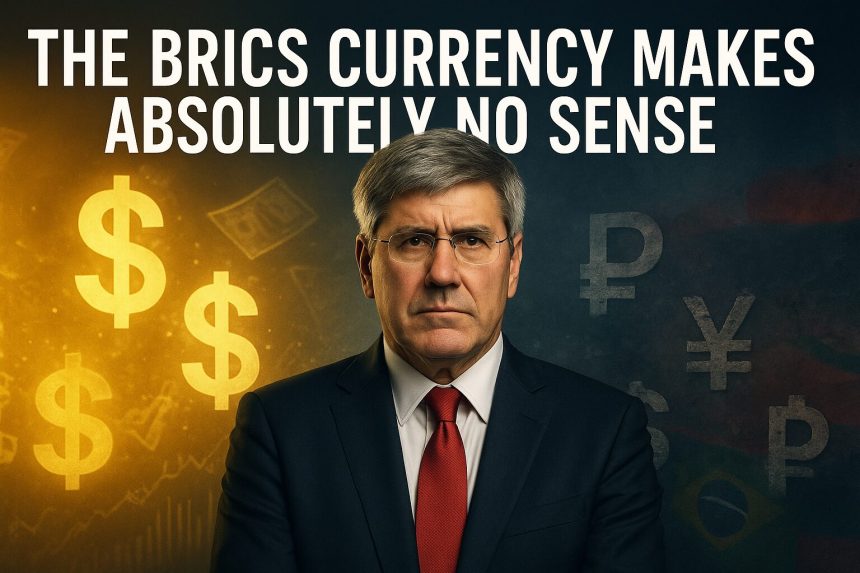Economist Steve Moore said the BRICS currency was meaningless and questioned why anyone would trust the ruble or Brazilian currency over the US dollar. For now, the BRICS currency is still targeted for launch in 2026, despite Trump's tariff threats and growing disagreements among member states over whether they want to move away from dollar-led trade.
BRICS currency progress, news, introduction date and why it's meaningless
Moore talks about why the BRICS currency is meaningless
On Fox Business, Moore spoke candidly about his skepticism. He explained why the idea of a BRICS currency doesn't make sense from his perspective, and also pointed out the fundamental trust issues involved.
Mr Moore said:
“The BRICS currency makes no sense at all. Who says I'm going to trust the ruble and the Brazilian currency? What about the renminbi? Obviously, the US dollar is the world currency and that will always be the case.”
The full BRICS currency refers to a reserve currency that will be backed by the currencies of Brazil, Russia, India, China, South Africa, and new member states such as Egypt and Iran. At the 2024 BRICS summit in Kazan, Russia, President Putin actually displayed what appeared to be a prototype BRICS banknote on stage, but quickly backpedaled on his earlier aggressive statements about ditching the dollar altogether.
President Putin told the audience at the summit:
“We are not rejecting the dollar, we are not fighting the dollar, but what can we do if they do not allow us to cooperate with the dollar? In that case, we will have to look for other alternatives, and that is what is happening.”
BRICS currency progress is slow
Progress in creating a BRICS currency has been disappointing at best. Neither President Vladimir Putin nor Chinese President Xi Jinping will appear at the 2025 Brazil summit, and talk of the BRICS currency is much quieter than before. Leslie Maasdorp, chief financial officer (CFO) of the New Development Bank, which represents the BRICS bloc, was quite clear about the current situation in an interview with Bloomberg.
Maasdorp was clear about the following facts:
“Developing an alternative is rather a medium- to long-term ambition. There is no proposal to create a BRICS currency at this time.”
India has also distanced itself from the whole idea. Indian External Affairs Minister S. Jaishankar made India's position clear when speaking at an event in London in March 2025, and his comments suggest that the BRICS currency is also meaningless for India.
Jaishankar said:
“I don't think there is a policy on our side to replace the dollar. The dollar as a reserve currency is a source of global economic stability, and what we want in the world right now is more economic stability, not less economic stability.”
BRICS currency launch date faces opposition from President Trump
The launch date for the BRICS currency has been discussed as 2026, but President Trump is working hard to ensure that never happens. On October 10, President Trump announced that he would impose 100% tariffs on Chinese goods starting November 1, marking a further escalation of US efforts to prevent a BRICS currency from becoming a reality.
Back in December, Trump posted on Truth Social about his demands:
“We demand a commitment from these countries not to create a new Brix currency or support any other currency to replace the mighty US dollar, or face 100% tariffs and be prepared to say goodbye to the great American economy.”
Trump also spoke about his approach in a recent appearance:
“We said whoever wants to join the BRICS, we're going to put tariffs on your country. They're all falling out. That was an attack on the dollar.”
But Kremlin spokesman Dmitry Peskov doesn't seem too concerned about Trump's threats. He noted that countries are already moving in different directions anyway, and that U.S. pressure could actually backfire.
Peskov said:
“More and more countries are switching to using their own currencies in trade and foreign economic activities. If the United States uses its economic power to force countries to use the dollar, this trend will become even stronger.”
What is actually happening instead?
Recent news regarding the BRICS currency shows that major member states are backing away from the idea. BRICS countries are focusing on blockchain-based payment systems instead of creating a unified currency, which many experts argue makes no sense. These systems allow us to reduce our dependence on the USD-dominated SWIFT platform without creating an entirely new currency.
As of this writing, the full shape of what the BRICS currency will actually look like remains unclear, and progress toward its launch date has essentially stalled. The US dollar still accounts for about 90% of all currency transactions, and such dominance was not built overnight.
The reality is that news about BRICS currency developments is more talked about than actual action. India's flat rejection in October 2023 of Russia's demand to pay for its oil in renminbi, insisting instead on the use of US dollars or rupees, showed how difficult cooperation between these countries really is. Moore's assessment that the BRICS currency is completely meaningless appears to be unfolding in real time as the 2026 target date approaches, with significant economic and political differences between the BRICS member states and no concrete progress.


